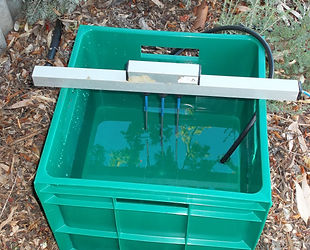Unpowered Measured Irrigation Controller
Universal Measured Irrigation Controller
MI Upgrade Kit with Level Sensor
When you use a DIY Solar Drip Irrigation Kit the irrigation starts at sunset provided that the water level has fallen below the float switch. This method or irrigation scheduling is called sunset scheduling.
For plants with deep roots or for plants in clay soils, it is preferable to irrigate with more water less frequently to enable the water to reach the bottom of the root zone. Between irrigation events the soil near the surface is allowed to dry out, but there should still me moisture in the root zone. If you decide that your plants need irrigating less frequently than daily (for example, once a week), then root zone scheduling is recommended.
If you want to adjust the irrigation frequency for your DIY Solar Drip Irrigation Kit and you still want a completely automatic system, then you will need to replace the float switch on the evaporator with a level sensor.
The level sensor has three probes as shown in the photo on the right. During the irrigation event the water level rises as water slowly drips into the evaporator from the control dripper. When the water level reaches the high probe on the right the irrigation stops. The water level then falls due to evaporation until the water level is below the low probe on the left at which point the irrigation recommences. The middle probe is a reference probe. This cycle continues indefinitely.
The volume of water required to raise the water level from the low probe level to the high probe level is called the control volume. It is also the volume of water that must evaporate between irrigation events.
As well as being completely automatic, the irrigation frequency responds to the prevailing weather conditions. During very hot weather the evaporation rate will be much greater and so the irrigation down time will be shorter. On cool overcast days, the evaporation rate will be quite small and so the irrigation down time will be longer. And when it rains the water level in the evaporator rises and delays the start of the next irrigation.
For further details download the DIY Solar MI Training Manual for Smallholders.

The control dripper drips water into the evaporator. The level sensor is resting on the evaporator with the low probe on the left and the high probe on the right. The irrigation frequency can be changed by adjusting the gap between the high probe and the low probe.

The switch on the irrigation controller has 3 positions: ON, OFF, and ON night only.
Is a level sensor preferable to a float switch?
For a fully automated system with a float switch and light sensor, the irrigation will start at sunset each day provided that the water level in the evaporator has fallen below the float switch. This means that unless it rains, there will be daily watering. For some plants less frequent watering is desirable. For example, a deep rooted fruit tree in heavy soil needs a lot of water infrequently so that the water can reach the root zone.
By using a level sensor with a large gap between the high probe and the low probe, you can give the plants a lot of water infrequently. It is important to realise that the weekly application rate is not affected by adjustments to the gap between the high probe and the low probe. If you double the gap, the amount of water used during each irrigation event will double, but the irrigation frequency will be halved. The downside of using a level sensor is that the irrigation control system is more expensive.
MI Upgrade Kit with Level Sensor
The upgrade kit is for anyone who has previously purchased the DIY solar drip irrigation kit from Measured Irrigation and wishes to replace the float switch in the evaporator with a level sensor with 3 probes.
The kit consists of the following components:
-
level sensor with 3 probes
-
MI upgrade kit adaptor
-
10 metres of electrical irrigation cable
The kit is available online from the Measured Irrigation Shop.
For further details download the DIY Solar MI Training Manual for Smallholders.
